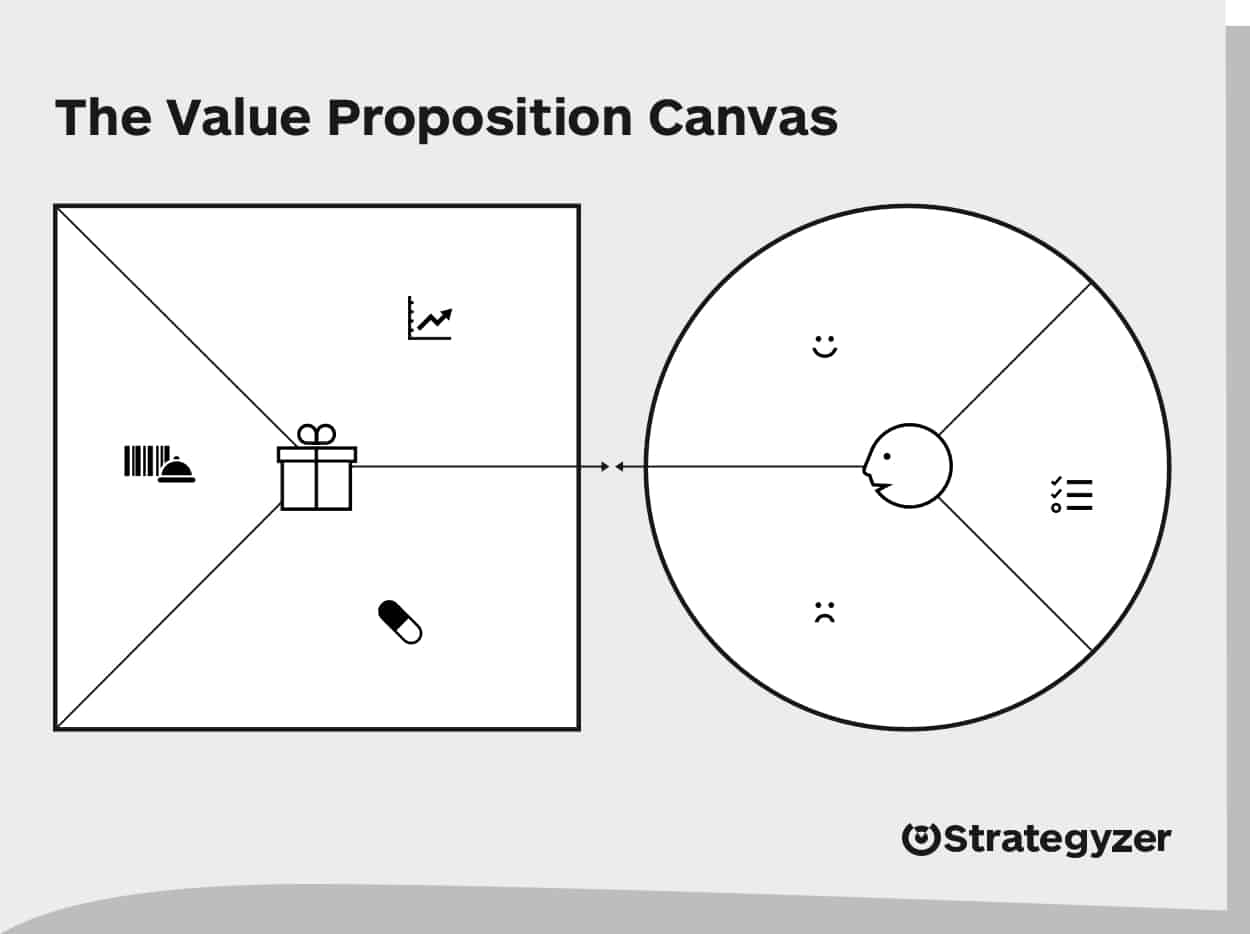One of the most important steps to building a business is to set a value proposition. By doing this, you can explain to lenders and investors the mission of your business and how you plan to achieve it. Without one, your business is an empty shell that will likely fail.
The value proposition canvas exists to help you avoid this error. Strategyzer founder Alex Osterwalder created this canvas to help entrepreneurs implement value propositions.
But what is a value proposition, and what does a value proposition canvas look like? Further, how can you use this tool to get your business on the right track?
In this guide to the value proposition canvas, you'll learn how to use Osterwalder's tool for success.
What is a Value Proposition?
If you've ever taken a look at the business model canvas by Alex Osterwalder, you'll be familiar with value propositions. Value propositions are one of the key aspects of your business model. They help you identify the value you offer and to whom.
Without a full understanding of your value proposition, you won't understand your target customers. As a result, you won't be unable to market to them properly and grow your business.
The first step to creating a value proposition is to identify your target customers. These customers are individuals or organisations to whom you are selling goods. On a business model canvas, this information goes into your customer segments box.
Once you've identified your target customers, write down their pain points. What problems do they experience that you solve with your products and services? Your business has value if it can solve your target customers' problems.
Then, you'll need to set your business apart from the competition. To do this, come up with your unique selling proposition (USP). Your USP can be anything you offer that your competitors don't or can't.
For example, you may own a pet store located in a town with three other pet stores. Your store is unique because it sells specialty food for dietary restrictions.
Finally, you'll need to express all these ideas in a concise one-sentence formula. This sentence will help you explain your business's mission to anyone who asks.
What is a Value Proposition Canvas?
A value proposition canvas is a chart that breaks down the values that your business offers. The chart helps you to segment each part of your value proposition into different aspects. As a result, you can explore them and identify areas that need work.
The value proposition can be used in one of two ways. First, you could use it to help build your business from scratch. Second, you can use it to test current products against your target customers' needs.
A quick glance at the value proposition canvas reveals a square and a circle, both of which include three sections. The square represents your business value while the circle represents your customers' needs. To fill out the chart, you'll want to dive deep into the products and services you offer and all the benefits they provide to your customers.
Benefits of a Value Proposition Canvas
The value proposition canvas is a business strategy tool that makes it easier to test your business. It benefits business owners by offering guidance in creating a successful business model.
One benefit is that this tool is great for visual learners and people who need to step outside the box. Because this tool is a chart, visual learners can use it to see their business model in a visual format. The chart helps you see each value and customer profile written down and connected with each other.
Further, turning otherwise complicated concepts into a chart format makes them easier to understand. Instead of looking at paragraphs of information, an entrepreneur breaks down each part to look at them individually. As a result, it is easier to see weak areas and flaws and fix them immediately.
Finally, the value proposition canvas helps you evaluate your target customer profiles and the products and services you offer so that you can adjust your marketing efforts. Hopefully, your marketing team or yourself has created buyer personas to best target your customers. When you're marketing, it's essential to know who to target and how, as well as how to best express your value.
Going through the process will help you better focus your marketing efforts and increase conversions.

Using The Value Proposition Canvas: Explained
In the same way that you would start creating your value proposition by defining your customer segments, you should start the value proposition canvas in the customer profile section. Once you've filled out the circle chart, you can move on to the square chart, which represents your business's values.
Filling Out Your Customer Profile
The key to a successful business model is offering solutions to your target customer's problems. That's why you must understand what your target customer needs before you tailor your products and services to them. The circle on the right of the value proposition canvas will help you do just that.
The circle is divided into three sections: jobs, pains, and gains.
Customer Jobs
The first section, customer jobs, represents what activities or tasks the customer can accomplish when they use your products or services. These "jobs" can be emotional, social, or functional. Anything the customer wants to achieve, whether it is a physical task or to satisfy a desire, is considered a job.
You might have a business that targets customers who want to perform social jobs. These jobs include desires or duties regarding relationships or society as a whole, whether through aspiration, fear, or more.
Or, you could have a business that speaks to customers who need to perform functional jobs, such as the need to travel, eat, or take care of their health.
Finally, your customers might have emotional jobs that derive from preferences or insecurities. They might want to satisfy their lifelong desire to drive a convertible or live on the beach.
For a simple example, if you sell pet care products, then your target customer can take care of your pet using your products. This example includes a functional job.
Sometimes, your customer jobs might be a mix of more than one type of job. Products and services you offer might speak to your target customer's emotional jobs as well as their social jobs. Make sure to be as thorough as possible when filling out this section.
Customer Pains
The second section represents your target customer's pain points. Pain points are factors that prevent your target customer from achieving the jobs that you've just outlined.
Some ways to identify pain points are:
- Ask what your customers feel isn't worth the money, time, or effort
- Figure out which current products and services available don't quite fit your target customers' needs
- Define the barriers that stop your target customer from taking advantage of solutions, such as education or difficulty with implementing them
- Outline societal consequences that might be preventing your target customer from solving their problems
Once you've identified the reasons why your target customers can't solve their own problems, you can figure out solutions that will work for them. Continuing with the pet store example, maybe your target customer is struggling to take care of their pet because stores in the area do not offer the proper food for digestive conditions.
Customer Gains
Finally, the third section describes what your target customers will gain when using your products or services. Customer gains are the positive effects that your customer wants to experience when solving their problems. In other words, these are the factors that motivate customers to take advantage of products and services.
To identify customer gains, you can ask yourself:
- What would make my customer happy?
- What would make my customer's life and job easier?
- What features is my customer looking for in the products and services I offer?
- What social consequences does my customer wish to experience when using my products and services?
- What expectations does my customer have for the products and services that will solve their problems?
Once you better understand what would make your customers motivated to buy your products and services, you can tailor your value to them. As a final part of the pet store example, your customers are probably hoping to experience more peace at home with their pets once they are healthy.
Filling Out the Value Map
Now that you've finished filling in your entire customer profile, you can move on to filling out the value portion of the value proposition canvas. The value map is the square chart to the left of the circle that is divided into three parts.
To fill out this section, you'll have to identify your products and services, pain relievers, and gain creators.
Products and Services
The first section of your value map is the products and services section. In this section, you should write out a list of all the products and services that your business offers as well as their detailed features. Naturally, this section will relate directly to the customer jobs section of the customer profile chart.
In the most basic circumstances, it's essential to have a comprehensive list of all your products and services on file, even if some are offered for free. This will help you keep your business organised and improve your marketing strategies.
In the case of your value proposition, you need to directly correlate the products and services you offer with the target customer's jobs. You should be able to express how your products and services help your customer achieve their jobs. For example, if your customer's job is to feed their pet a healthy diet, your product is healthy pet food.
Pain Relievers
The second section of the value map is the pain relievers you offer. This segment should include how your business removes the pains of your target customers. Of course, this section should directly relate to the customer pains section you filled out in your customer profile chart.
This section gets a little more complicated than the first because it requires you to explain how your products and services solve your customer's pain points rather than just list them. Doing this in-depth, however, will help you better understand how your business is valuable to your target customer.
If you target customer's pain point is that they can't find healthy pet food locally, then your pain reliever might be that you deliver healthy pet food to their door. As a result, that pet owner no longer has to be frustrated or stressed about keeping their pet healthy.
Gain Creators
Finally, the third section should express how your business offers opportunities for your target customer to experience the gains they desire. These gain creators include anything that sets your business apart from the competition and improves the customer's experience as well as fulfils their needs and desires. Naturally, this section will directly relate to the customer gains portion of the customer profile chart.
To define your gain creators, think of ways your products and services go beyond just solving your customers' issues. Does your product or service exceed expectations or help them achieve their dreams? Do your best to outline how your products and services answer the customer gains section of your customer profile.
For example, by offering healthy pet food to frustrated pet owners, you are helping the pet owners to start living their full lives again with their pets rather than tending to their health conditions.
Get To Know Your Target Customer
With proper use of the value proposition canvas, you'll get to know your target customer enough to directly answer all of their needs and desires. In return, they'll be highly motivated to support your business.
If you're looking for further guidance, Lift Strategies is a business consulting agency consisting of trusted advisors for small and medium-sized businesses. We can assist you in formulating your value proposition and business model with a great chance of success. Contact us now for a free discovery session.





